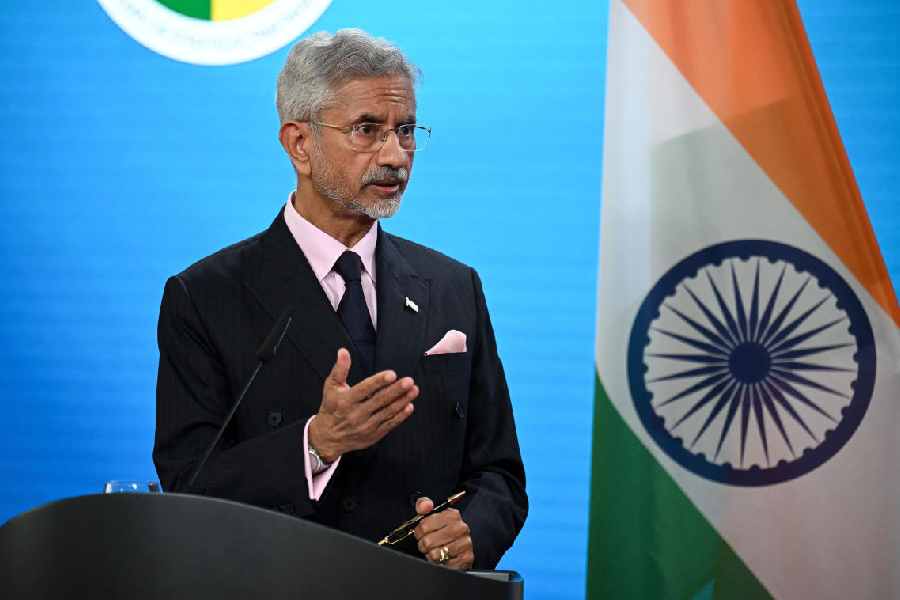|
|
On December 6, 2009, the Copenhagen Conference on climate change started with more anxiety than hope. To iron out the conflicts of interest and arrive at a consensus appear to have been on the top of the agenda. Economic progress, higher consumption of energy, carbon dioxide (even monoxide) enveloping the planet, greenhouse effects and so on are intimately connected. Not surprisingly, therefore, the United States of America topped the list of this irreversible menace.
On the same day, one of the most enlightened governors, Gopal Krishna Gandhi, introduced solar power to light up the magnificent Raj Bhavan at night in the presence of the president. Whatever may be the truth or untruth, expressing concern about climate change is no longer about hopping on to a fashionable bandwagon. Clearly, there is a serious problem at hand. The clash between ‘progress’ and the survival of the planet has become a crucial issue at present. Public awareness of this impending disaster has been quite incredible, particularly in those countries that have been primarily responsible for precipitating the crisis. On the other hand, no country, by far and large, wants to take a drastic step to reduce carbon emission perceptibly. One needs to go through the recent history of world energy to examine the damage man has already wrought on ecology, as well as to understand how the human race can save itself.
What are the sources of energy? Oil counts for about 35 per cent of energy consumption in the world; next comes coal, going upto 25 per cent, and natural gas with about 25 per cent. Thus, more than 80 per cent of the world’s energy comes from burning fossil fuel. Fossil-fuel-generated energy resources are directly responsible for carbon emission and the consequent damage to the environment. On the other hand, it is now evident that nuclear power-based electric energy is the safest and cleanest. Compared to the innumerable disasters at coal mines, and considering the aspect of carbon emission, nuclear power is relatively safe. Nuclear waste, too, is a minor problem that is now well under control.
The world average of nuclear electricity is about seven per cent of the total world energy. India still remains at the three per cent level in the nuclear sector, whereas France produces around 80 per cent of electric power from nuclear resources.
World energy use is expected to grow by 50 per cent by 2030. Alleviation of the misery of the poor is the central objective in this context. About 80 per cent of this enormous energy requirement is fed by burning fossil fuel, a process that irreversibly contributes to climate change and pollution. At the current rate of consumption, crude oil can last for 20 years, coal for 150 years but, with only a five per cent increase in demand, for only 50 years, and gas for a mere 30 years.
With the discovery of new sites, the life span of these resources can be extended only marginally. So, to maintain a reasonably healthy planet, we need to devise a method to use energy more efficiently. However, reversing the dominance of fossil products — a trend that has continued for over three centuries — may not be accomplished easily.
Let us examine the accumulated horror of burning fossil fuel. A staggering 300,000 coal pollution related deaths take place in China every year. The graveness of the situation has been aptly captured in the following Saudi slogan: “My father rode a camel. I drive a car. My son flies a plane. His son will ride a camel once again”. Industrial revolution was driven by the abundance of cheap fossil energies. The horrifying fact is that anthropogenic carbon dioxide release affects the climate for hundreds of thousands of years. This realization has not yet seeped into public awareness, whereas nuclear waste continues to bother the world.
Let us now look at the recent fate of that wonderful, enigmatic, and permanently ice-covered area called Greenland. Greenland’s ice sheet melt area has increased on an average of 16 per cent, at the rate of about 1 per cent per year. The surface area of summer sea ice floating in the Arctic was nearly 23 per cent below the previous record. In fact, the northwest passage opened up to even navigation. Surface temperatures in the Arctic ocean this summer were the highest in 77 years. By 2020-40, all the summer sea ice may be gone at this rate. The induced warming may also lead to the subsequent melting of the ice sheet. An incredible 550 billion tonnes of melted ice will then be released into the oceans. The truth is that the speed of the reduction of the sea ice is growing much more rapidly than the worst predictions. The meltdown of Greenland’s ice caps may cause sea levels to rise between 7 to 15 metres. Calcutta and its surrounding ‘delta’ island of Bangladesh have already gone on to a more than dangerous level. Recently, the prime minister of the Maldives held a cabinet meeting under the sea in a dramatic display of the imminent doomsday.
Thus, the inevitable conclusion is that carbon dioxide emission is a serious threat to mankind. Ironically, on an average, the Chinese emit just 3.5 tonnes of carbon dioxide every year. The Britons, on the other hand, emit nearly 10 tonnes and the Americans 20 tonnes. India’s emission rate is lower than China’s, and considerably lesser than those of the United Kingdom and the US. No wonder the Copenhagen Conference got murky at times. Unfortunately, there is no easy way out either.
Let us examine briefly the nuclear and then the solar option. India, after the Indo-US nuclear deal, has access to uranium from other countries. Before the deal was struck, no country was keen to supply uranium to India without a ‘nod’ from the US. Otherwise, they risked losing ground in global business and commerce which they could not possibly afford. India is also going through a nuclear renaissance. Just the other day, the fifth unit of the Rajasthan Atomic Power Plant got connected to the main grid. A large number of reactors are being commissioned or planned across the country as well. The Nuclear Power Corporation of India Limited is spearheading the nuclear power programme in the country, that too with considerable success. By 2020, India should have 20,000 megawatts. With the completion of the projects under construction in Rajasthan, Karnataka and Tamil Nadu, the figure will increase to 7,280 MWs by 2012. The long- term plan is to take the production level close to 60,000 MWs by 2032, while introducing novel and new technologies in the power reactor.
Where does Bengal stand in this new wave of nuclear renaissance? The plan is to build six units of 1,000 MWs each at Haripur in Midnapore. This has been approved by the government of India already. Deep in the South, at the very end of India, Kudankulam is going to have two of these 1,000 MWs reactors in collaboration with the Russians. Haripur, located in Bengal, is three times larger.
Significantly, the reactors will not be housed on fertile land but on a marshy stretch. The local inhabitants will be real time partners just as in the cases of the other reactor sites such as Kalpakkam near Chennai. Schools, colleges, hospitals and other facilities will be built and the fishermen will have absolutely no problems in continuing with fishing in a cleaner environment. That is exactly what has happened in Kalpakkam.
But, despite the amazing growth in nuclear-power production, it is estimated that by 2030-32, the total share of nuclear power will touch two digits in the country. It is being estimated that it will be a mere 10 per cent of the total requirement. Even in the global context, if human civilization were to escape from the greenhouse nightmare, then mankind needs to tap every possible source of alternative renewable energy to obliterate the dependence on fossil fuel. What about tapping the ultimate and the most fundamental source of all energy — the essential source of energy in our lives on the planet — the sun? The Greek scientist, scholar and philosopher, Archimedes, had managed to devise a simple method of using a huge lens to direct the light to ignite the massive wooden structures of ships during the siege of Syracuse. Indeed, the first solar facility to produce electricity was installed way back in 1912 by Schumann and Maadi in Egypt.
The parabolic mirror trough concentrates sun rays as a line focus in which a tube was installed containing water, which eventually came to boil and then produced electricity. This extraordinarily simple device produced 5 kilowatts of electric power.
The great Sahara desert is an incredibly powerful solar powerhouse. A stretch of 210 x 210 sq km of the desert, which is only 0.13 per cent of the entire area, is a reservoir of solar energy whose quantum equals that of the entire global energy consumption.
An enormous amount of research and engineering work is going on at present to harness solar power economically. The Photo Voltaic cell still remains expensive and is hence not viable economically. The Nobel laureate, and a great advocate of solar power, Carlo Rubbia, puts it thus: “Just as Microsoft changed everything on earth...we have to invent more novel and attractive way to use solar energy efficiently.” In Spain, for example, Plataforma Solar Sanlúcar la Mayor produces 300 MWs by installing a simple reflector, thereby avoiding 600,000 tonnes of carbon dioxide emanation. Even in Nevada, such experiments have been hugely successful. There are many other examples of this.
In India, we are quite advanced in nuclear power, but are miserably behind in the case of using solar power. This, despite the fact that the sun has remained as the centre of our general psyche and activities. The abundance of sunlight, however, remains under-utilized in this part of the world.The world needs a transition from fossils to solar energy, and the revolution has to start right here.
Mankind has gone through numerous revolutions in the course of its history. The revolution that daunts us, indeed stares at us at the moment, is not a social or political revolution. In fact, it involves revolutionizing our basic perceptions on life, ways of living and the future. The time is ripe for a quantum shift in our mindset. The journey, however, is long and full of obstacles and may pose a challenge to our fossilized minds.











